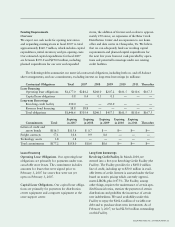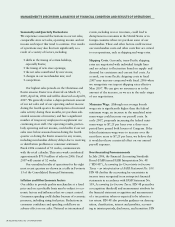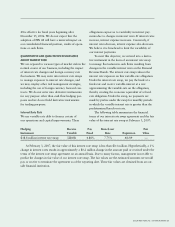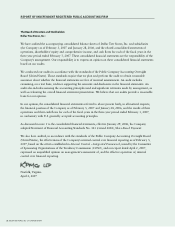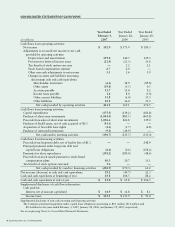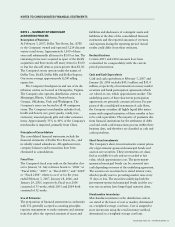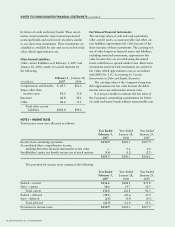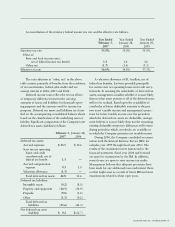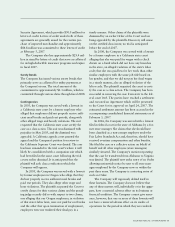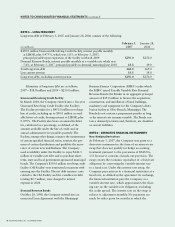Dollar Tree 2006 Annual Report Download - page 33
Download and view the complete annual report
Please find page 33 of the 2006 Dollar Tree annual report below. You can navigate through the pages in the report by either clicking on the pages listed below, or by using the keyword search tool below to find specific information within the annual report.
NOTE 1 – SUMMARY OF SIGNIFICANT
ACCOUNTING POLICIES
Description of Business
At February 3, 2007, Dollar Tree Stores, Inc. (DTS
or the Company) owned and operated 3,219 discount
variety retail stores. Approximately 3,100 of these
stores sell substantially all items for $1.00 or less. The
remaining stores were acquired as apart of the Deal$
acquisition and these stores sell many items for $1.00
or less but also sell items at prices greater than $1.00.
The Company’s stores operate under the names of
Dollar Tree, Deal$, Dollar Bills and Dollar Express.
Our stores average approximately 8,200 selling
square feet.
The Company’s headquarters and one of its dis-
tribution centers are located in Chesapeake, Virginia.
The Company also operates distribution centers in
Mississippi, Illinois, California, Pennsylvania,
Georgia, Oklahoma, Utah and Washington. The
Company’s stores are located in all 48 contiguous
states. The Company’s merchandise includes food,
health and beauty care, party goods, candy, toys,
stationery, seasonal goods, gifts and other consumer
items. Approximately 35% to 40% of the Company’s
merchandise is imported, primarily from China.
Principles of Consolidation
The consolidated financial statements include the
financial statements of Dollar Tree Stores, Inc., and
its wholly owned subsidiaries. All significant inter-
company balances and transactions have been
eliminated in consolidation.
Fiscal Year
The Company’s fiscal year ends on the Saturday clos-
est to January 31. Any reference herein to “2006” or
“Fiscal 2006,” “2005” or “Fiscal 2005,” and “2004”
or “Fiscal 2004” relates to as of or for the years
ended February 3, 2007, January 28, 2006, and
January 29, 2005, respectively. Fiscal year 2006
consisted of 53 weeks, while 2005 and 2004 both
consisted of 52 weeks.
Use of Estimates
The preparation of financial statements in conformity
with U.S. generally accepted accounting principles
requires management to make estimates and assump-
tions that affect the reported amounts of assets and
DOLLAR TREE STORES, INC. • 2006 ANNUAL REPORT 31
NOTES TO CONSOLIDATED FINANCIAL STATEMENTS
liabilities and disclosures of contingent assets and
liabilities at the date of the consolidated financial
statements and the reported amounts of revenues
and expenses during the reporting period. Actual
results could differ from those estimates.
Reclassifications
Certain 2005 and 2004 amounts have been
reclassified for comparability with the current
period presentation.
Cash and Cash Equivalents
Cash and cash equivalents at February 3, 2007 and
January 28, 2006 includes $40.3 million and $31.4
million, respectively, of investments in money market
securities and bank participation agreements which
are valued at cost, which approximates market. The
underlying assets of these short-term participation
agreements are primarily commercial notes. For pur-
poses of the consolidated statements of cash flows,
the Company considers all highly liquid debt instru-
ments with original maturities of three months or less
to be cash equivalents. The majority of payments due
from financial institutions for the settlement of debit
card and credit card transactions process within three
business days, and therefore are classified as cash and
cash equivalents.
Short-Term Investments
The Company’s short-term investments consist prima-
rily of government-sponsored municipal bonds and
auction rate securities. These investments are classi-
fied as available for sale and are recorded at fair
value, which approximates cost. The government-
sponsored municipal bonds can be converted into
cash depending on terms of the underlying agreement.
The auction rate securities have stated interest rates,
which typically reset to prevailing market rates every
35 days or less. The securities underlying both the
government-sponsored municipal bonds and the auc-
tion rate securities have longer legal maturity dates.
Merchandise Inventories
Merchandise inventories at the distribution centers
are stated at the lower of cost or market, determined
on a weighted average cost basis. Cost is assigned to
store inventories using the retail inventory method,
determined on a weighted average cost basis.


